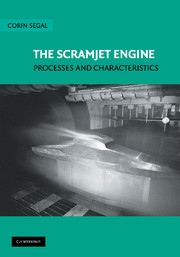Book contents
- Frontmatter
- Contents
- Preface
- List of Acronyms
- 1 Introduction
- 2 Theoretical Background
- 3 High-Temperature Gas Dynamics and Hypersonic Effects
- 4 Cycle Analyses and Energy Management
- 5 Inlets and Nozzles
- 6 Supersonic Combustion Processes
- 7 Testing Methods and Wind Tunnels
- 8 Computational Fluid Dynamic Methods and Solutions for High-Speed Reacting Flows
- Index
- References
7 - Testing Methods and Wind Tunnels
Published online by Cambridge University Press: 19 January 2010
- Frontmatter
- Contents
- Preface
- List of Acronyms
- 1 Introduction
- 2 Theoretical Background
- 3 High-Temperature Gas Dynamics and Hypersonic Effects
- 4 Cycle Analyses and Energy Management
- 5 Inlets and Nozzles
- 6 Supersonic Combustion Processes
- 7 Testing Methods and Wind Tunnels
- 8 Computational Fluid Dynamic Methods and Solutions for High-Speed Reacting Flows
- Index
- References
Summary
Introduction
At Mach 5, the stagnation temperature approaches the structural limit acceptable for full simulation and continuous operation of a ground-based wind tunnel. With considerable effort, long-duration wind-tunnel operation could be extended beyond this figure and, in fact, several capabilities exist in different places around the world. Experimental conditions above Mach 10 can be duplicated only in short-duration facilities, so the topics studied in these devices must be carefully selected to ensure that the physical processes to be reproduced are compatible with those experienced in flight. Much of the hypersonic flight domain remains to be covered through theoretical analysis and, most likely limited, flight testing.
Despite the practical difficulties, considerable progress has been made through experimental studies, in particular in the domain covering the transition from ramjet to scramjet operation, in the range of Mach 4–6. Beyond this range, several short-duration flights were performed using boosters; basic studies were undertaken in shock and expansion tubes at high Mach numbers.
The following is a brief summary, mostly of the hypersonic simulation requirements and the capabilities offered by typical experimental facilities. Of the numerous studies completed in ground facilities around the world, only a few are referenced here as examples. For detailed reviews of current facilities and experimental programs, the volumes edited by Curran and Murthy (2000) and Lu and Marren (2002), as well as the review by Arnold and Wendt (1996) and the RAND report by Anton et al. (2004), are particularly recommended.
Information
- Type
- Chapter
- Information
- The Scramjet EngineProcesses and Characteristics, pp. 215 - 228Publisher: Cambridge University PressPrint publication year: 2009
